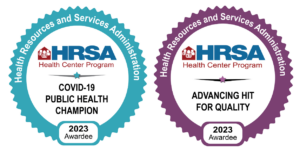 August is Psoriasis Awareness Month. Through the assistance of the National Psoriasis Foundation (NPF), Careteam+ is pleased to share information for treating and managing psoriatic disease to empower you to take control of your health.
August is Psoriasis Awareness Month. Through the assistance of the National Psoriasis Foundation (NPF), Careteam+ is pleased to share information for treating and managing psoriatic disease to empower you to take control of your health.
What is psoriasis?
Psoriasis is an autoimmune disease that causes raised, red, scaly patches to appear on the skin.
It typically affects the outside of the elbows, knees or scalp, though it can appear on any location. Some people report that psoriasis is itchy, burns and stings. It is often associated with other serious health conditions such as diabetes, heart disease and depression.
If you develop a rash that doesn’t go away with an over-the-counter medication, you should consider contacting your health care provider.
How do I get psoriasis?
While scientists don’t know exactly what causes psoriasis, they do know that the immune system and genetics play major roles in its development. Usually, something triggers psoriasis to flare. The skin cells in people with psoriasis grow at an abnormally fast rate, which causes the buildup of psoriasis lesions.
Men and women develop the disease at equal rates. While it occurs in all racial groups, it occurs at varying rates. About 1.9 percent of African-Americans have psoriasis, compared to 3.6 percent of Caucasians.
Although it often develops between the ages of 15 and 35, it can appear at any age. About 10 to 15 percent of those with psoriasis get it before age 10, and some infants have psoriasis, although this is considered rare.
Psoriasis is not contagious. It is not something you can “catch” or that others can catch from you. Its lesions are not infectious.
How is psoriasis diagnosed?
There are no special blood tests or tools to diagnose psoriasis. Your health care provider usually examines the affected area to determine if it is psoriasis.
He/she may take a piece of the affected skin (a biopsy) and examine it under the microscope. When biopsied, psoriasis skin looks thicker and inflamed when compared to skin with eczema.
Natali Amaradasa APRN, Medical Provider for Careteam+, is uniquely qualified to diagnose psoriasis and prescribe the proper treatment.
Where does psoriasis show up?
Psoriasis can show up anywhere—on the eyelids, ears, mouth and lips, skin folds, hands and feet, and nails. The skin at each of these sites is different and requires individual treatment.
How severe is my psoriasis and what is the treatment?
Psoriasis can be mild, moderate or severe. Your treatment options may depend on how severe your psoriasis is. Severity is based on how much of your body is affected. (The surface area of the hand equals about 1 percent of the skin.) The severity of psoriasis is also measured by how it affects a person’s quality of life. For example, psoriasis can have a serious impact on one’s daily activities even if it involves a small area, such as the palms of the hands or soles of the feet.
Topical treatments, such as moisturizers, over-the-counter and prescription creams and shampoos are typically used for mild psoriasis.
Treating moderate to severe psoriasis usually involves a combination of treatment strategies. Besides topical treatments, your doctor may prescribe phototherapy (also known as light therapy) or medication, especially if your psoriasis is significantly impacting your quality of life.
Will I develop psoriatic arthritis?
About 11 percent of those diagnosed with psoriasis have also been diagnosed with psoriatic arthritis, and approximately 30 percent of people with psoriasis will eventually develop the disease.
While it may often go undiagnosed, particularly in its milder forms, it’s important to treat psoriatic arthritis early to help avoid permanent joint damage.
What about psoriasis in children?
Every year, roughly 20,000 children under 10 years of age are diagnosed with psoriasis. Sometimes it is misdiagnosed because it is confused with other skin diseases. Symptoms include pitting and discoloration of the nails, severe scalp scaling, diaper dermatitis or plaques similar to that of adult psoriasis on the trunk and extremities. Psoriasis in infants is uncommon, but it does occur. Only close observation can determine if an infant has the disease.
If one parent has the disease, there is about a 10 percent chance of a child contracting it. If both parents have psoriasis, the chance increases to 50 percent. No one can predict who will get psoriasis. Scientists believe that at least 10 percent of the general population inherits one or more of the genes that create a predisposition to psoriasis, although only 2 to 3 percent of the population will actually develop the disease.
The onset of psoriasis often follows an infection, particularly strep throat. One-third to one-half of all children with psoriasis may experience a flare-up two to six weeks after an earache, strep throat, bronchitis, tonsillitis or a respiratory infection. Areas of skin that have been injured or traumatized may also be the site of psoriasis, known as the “Koebner [keb-ner] phenomenon.” It is important to note, however, that not everyone who has an injury will develop psoriasis.
The good news is that psoriatic disease research has evolved at a remarkable pace. We now have more treatment options than ever before, and we’re seeing some good results. In addition, there are things you can do to take control of your disease. It all starts with getting informed.
Learn more about psoriasis at www.psoriasis.org
Source: The National Psoriasis Foundation


